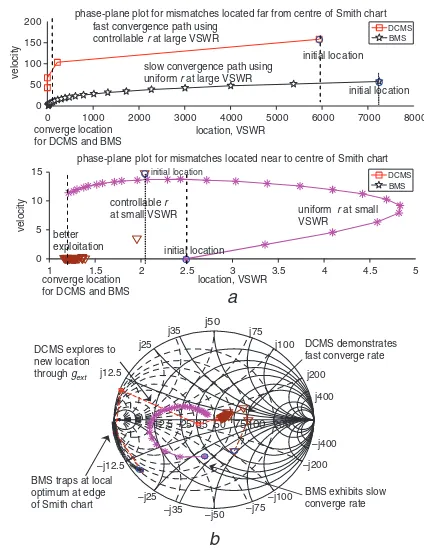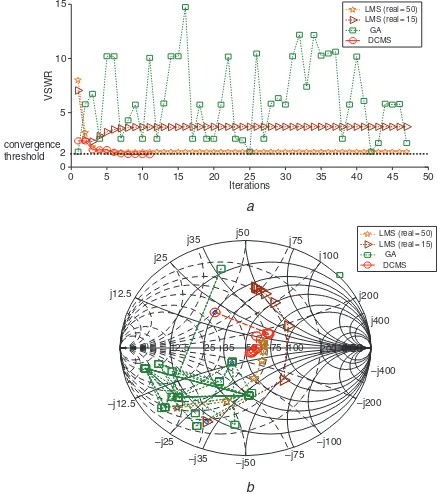Speedy derivative-corrective mass spring
algorithm for adaptive impedance matching
networks
Y.C. Wong, T. Arslan, A.T. Erdogan, N. Haridas and
A.O. El-Rayis
Adaptive impedance matching algorithms are used to preserve the link quality of mobile phones, under fluctuating user conditions. It is highly desirable to reduce the search time for minimising the risk of data loss during the impedance tuning process. Presented is a novel technique to reduce the search time by more than an order of magnitude by exploit-ing the relationships among the mass sprexploit-ing’s coefficient values derived from the matching network parameters, thereby significantly reducing the convergence time of the algorithm.
Introduction: The demand for small size antennas is increasing for the next generation wireless devices. However, a small size antenna inher-ently has impedance that varies rapidly with frequency and the user’s environment. This can cause substantial impedance variations over time, for instance the proximity of a mobile phone handset’s antenna to the user’s body. For this reason, an adaptive impedance matching network (AIMN) is required to correct antenna impedance mismatches and maximise the transmission power. Linear correlation methods, such as linear mean square (LMS), have been reported for tuning the real[1]and imaginary[2]parts of the antenna impedance. However, these methods are able to match either the real or imaginary part of the impedance but not both parts simultaneously owing to the nonlinear correlation of the tuner components. To correct both real and reactive mismatches, researchers applied a specific genetic algorithm (GA) [3, 4]. However, GAs are computationally very expensive and exhibit slow convergence speed. The tuning process of the adaptive impedance matching network changes the amplitude and phase of the signal radiated, hence transmitted data may be corrupted if tuning happens during transmission. Therefore, it is desirable to perform tuning during very limited idle periods in order to minimise the risk of data loss. This shows the need for a fast and computationally less complex algorithm to correct both real and reactive parts of antenna impedance mismatches. In this Letter, we propose a novel speedy derivative-corrective mass spring (DCMS) algorithm for adaptive impedance matching networks. The performance of the proposed algorithm is eval-uated by simulations, demonstrating shorter convergence time compared to the GA and better accuracy compared to LMS based methods.
Derivative-corrective mass spring (DCMS) algorithm: An adaptive impedance matching network consists of tunable impedance that couples a load to a resistive generator over a frequency band of interest, as shown inFig. 1a. Tunable impedance networks are mostly based on
LC- orPi-networks, as shown inFig. 1b.
adaptive impedance matching network
+ voltage standing wave
X2 X2 X2
fZinZLoad,XNi,t
l
a b
Fig. 1Block diagram of adaptive impedance matching network
aMatching network parameters
bCommon impedance networks:LC-network andPi-network
The input impedance (Zin) is a function of the load (ZLoad) and an array of tunable network parameters withNelements (XiN,t)[5]. The voltage standing wave ratio (VSWR) is used as a measure of impedance mismatch based on the reflection coefficient (G), as shown by (1) and (2).
G=fZin{ZLoad,X
The evolution of the proposed DCMS algorithm is governed by the fundamental second-order numerical differential method for a basic mass spring (BMS) [6]. The force exerted by the spring (F) is proportional to the stiffness of the spring (k) and the vicious damping coefficient (r), as shown by (3). Applying a finite-difference approxi-mation for the BMS in (3), and incorporating the related network parameters in (1) and (2), we derive the next step velocity (ViN,t+1) and
In the BMS algorithm, a uniformris used. However, in our proposed DCMS algorithm, parameterris controlled by the VSWR while the VSWR is determined by G and Zin, which are derived from the current displacement (XiN,t). Zin, which is closer to the co-ordinate of the Smith chart, has lower VSWR; while Zin, which is far from the centre of the Smith chart, exhibits higher VSWR. The parameterris incorporated withViN,t+1andXiN,t+1, as shown in (4) and (5). A higher
velocity is imposed on individuals which are located far from the centre of the Smith chart, as shown inFig. 2a. Whereas, the velocity decays towards the centre of the Smith chart, making the individuals exploiting their current locations better. This enhances the convergence speed of the DCMS significantly compared to the BMS, as shown in
Fig. 2a.
0 1000 2000 3000 4000 5000 6000 7000 8000 0
phase-plane plot for mismatches located far from centre of Smith chart
1 1.5 2 2.5 3 3.5 4 4.5 5
phase-plane plot for mismatches located near to centre of Smith chart
DCMS for DCMS and BMS converge location for DCMS and BMS
initial location fast convergence path using
controllable r at large VSWR
slow convergence path using uniform r at large VSWR
better exploitation
uniform r at small VSWR controllable r
at small VSWR
a
BMS traps at local optimum at edge of Smith chart
DCMS explores to new location through gext j12.5
DCMS demonstrates fast converge rate
BMS exhibits slow converge rate
b
DCMS BMS
Fig. 2Comparison of proposed DCMS with BMS for different mismatches
aBased on velocities and current locations of individuals in phase-plane plot bBased on complex input impedances (Zin) in Smith chart
The BMS will always be trapped in local optimum when the mismatch impedance is located at the edge of the Smith chart, as shown inFig. 2b. For the proposed DCMS, an external random force (0,gext,1) is applied to re-tune the direction of convergence when the individuals go out of user-defined boundaries (e.g. |imag(Zin)|.100V) or the
potential tuning parameters are invalid (XiN,t,0). This external force in the DCMS circumvents the limitation of the numerical method which is sensitive to the initial values and enables better extrapolation to its neighbourhood.
Results and discussion: The DCMS algorithm was tested with two topologies, i.e.LC- andPi-network. The algorithm stops as soon as a user-defined threshold for the VSWR is reached (e.g. VSWR,2) or the maximum number of iterations (48) is exceeded. The results show that the DCMS outperforms both the LMS and the GA with its very fast convergence speed and high accuracy, see Figs. 3a and b. The LMS shows a moderate convergence speed compared to the DCMS owing to its constant step size. However, the LMS is unable to converge when both real and imaginary parts are involved in the tuning process, as shown inTable 1. The GA and the DCMS have close average conver-gence rates, although the GA’s converconver-gence rate could be improved further by allowing longer simulation time and increasing the number of chromosomes. However, the GA has the longest average CPU time which is more than 40 times slower compared to the DCMS.
0 5 10 15 20 25 30 35 40 45 50 0
5 10 15
Iterations
VSWR
LMS (real = 50) LMS (real = 15)
GA DCMS
2 convergence threshold
400
200 100 75 35 25
12.5 50 400
–j50 –j35 –j25 –j12.5
–j75 –j100
–j200 –j400 j400 j200 j100 j75 j50 j35 j25
j12.5
a
b
LMS (real = 50) LMS (real = 15)
GA DCMS
Fig. 3Convergence of LMS, GA and DCMS
aBased on VSWR over number of iterations
b Based on complex input impedances (Zin) in Smith chart
Table 1:Average VSWR and CPU time for DCMS, LMS and GA in 1000 runs based on LC- and Pi-network for mismatches involving both real and imaginary part of ZLoad (15+j15.6) and solely the imaginary part of ZLoad(50+j15.6)
Adaptive algorithm
AIMN Elements in ZLOAD
to be corrected
Average VSWR
CPU
time (ms) Comments
DCMS
LC Real and imaginary 1.7643 2.9
Fast and good convergence rate
Imaginary only 1.2134 2.8
Pi Real and imaginary 1.4561 12.4
Imaginary only 1.2053 13.1
LMS
LC Real and imaginary 6.3731 16.4 Unable to converge(VSWR.2) for mismatches involving both real and imaginary
parts
Imaginary only 1.4539 18.9
Pi Real and imaginary 3.6866 20.4
Imaginary only 1.0979 20.3
GA
LC Real and imaginary 1.3258 539.7
Slow CPU time
Imaginary only 1.0879 536.9
Pi Real and imaginary 1.3921 544.6
Imaginary only 1.2028 556.8
Conclusion: For adaptive impedance matching networks, we have presented a novel derivative-corrective mass spring (DCMS) algorithm which has faster convergence speed and is more robust than existing algorithms, i.e. the LMS and the GA. The proposed DCMS algorithm can intelligently increase diversity and escape from local optimum traps, enabling it to converge to solutions faster. Moreover, it can adaptively determine the next step velocities and displacements, which significantly reduce the number of searching steps required. The reduction in search time is very important for reducing the risk of data loss and achieving better link quality for next generation green mobile applications.
Acknowledgments: The authors acknowledge the financial support from Universiti Teknikal Malaysia Melaka, the Malaysian Government and Scottish Enterprise.
#The Institution of Engineering and Technology 2012
7 March 2012
doi: 10.1049/el.2012.0743
One or more of the Figures in this Letter are available in colour online. Y.C. Wong, T. Arslan, A.T. Erdogan, N. Haridas and A.O. El-Rayis (Advanced Smart Antenna Technologies Research Group, School of Engineering, The University of Edinburgh, Edinburgh, EH9 3JL, United Kingdom)
E-mail: [email protected]
References
1 Lopez-Delgadillo, E., Garcia-Andrade, M.A., Diaz-Mendez, J.A., and
Maloberti, F.: ‘Automatic impedance control for chip-to-chip
interconnections’. 15th IEEE Int. Conf. on Electronics, Circuits and Systems, (ICECS 2008), pp. 332 – 335, St Julians, Malta, 2008 2 van Bezooijen, A., de Jongh, M.A., Chanlo, C., Ruijs, L.C.H., van
Straten, F., Mahmoudi, R., and van Roermund, A.H.M.: ‘A GSM/
EDGE/WCDMA adaptive series-LC matching network using
RF-MEMS switches’,IEEE J. Solid-State Circuits, 2008,43, pp. 2259– 2268 3 Rodriguez, J.L., Garcia-Tunon, I., Taboada, J.M., and Basteiro, F.O.: ‘Broadband HF antenna matching network design using a real-coded
genetic algorithm’, IEEE Trans. Antennas Propag., 2007, 55,
pp. 611 – 618
4 Kato, A., Ogawa, K., Iwai, H., and Yamamoto, A.: ‘Mobile radio
apparatus capable of adaptive impedance matching’, US Patent No: US 7528674 B2, May 5, 2009
5 Pozar, D.M.: ‘Microwave engineering’ (John Wiley & Sons, Inc., 1998) 6 Provot, X.: ‘Deformation constraints in a mass spring model to describe
rigid cloth behavior’,Graphics Interface, 1995, pp. 147 – 154

